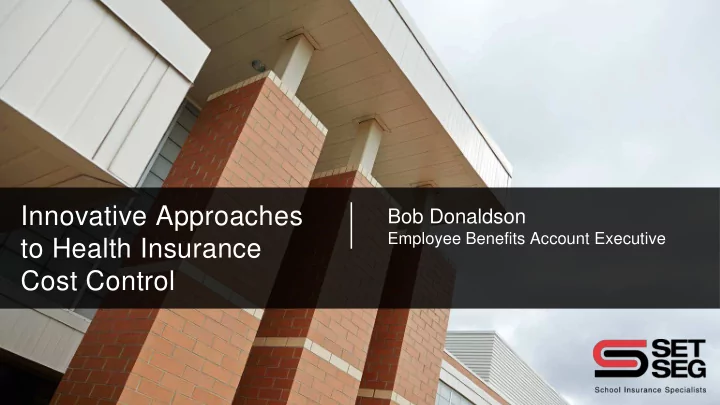

Innovative Approaches Bob Donaldson Employee Benefits Account Executive to Health Insurance Cost Control
EMPLOYEE BENEFIT SERVICES Bob Donaldson Employee Benefits Account Executive SET SEG 517-816-1665 bdonaldson@setseg.org
OVERVIEW 1 Understand current climate 2 The problem with Health Savings Accounts 3 Self funding 4 Rx Carve Out 5 Direct Primary Care 6 Reference Based Pricing 7 Direct Contracting/Medical Tourism
CHANGING CLIMATE OF HEALTH CARE In the last 15 years, annual premiums have risen: 185 percent for single coverage $2,196 in 1999 $6,251 in 2015 200 percent for family coverage $5,791 in 1999 $17,545 in 2015
HEALTH INSURANCE EVOLUTION 1980’s 1990’s 2000’s 2010’s 2020’s Closed Competition Consumerism Compliance Control System HMO’s PPO’s HSA Carrier vs. Carrier PA 106 PA 152 ACA
HAS CONSUMERISM FAILED? Consumerism: Encouraging the patient, through high deductibles, to “shop” for healthcare services with the hope that this will create competition that will lower prices. • Employees lack buying power and leverage • Employers are true consumers
HSAs • Lower monthly premiums • Pay less if you use less • Deliver high-level benefit •Tax savings •Potential savings of 20-30% vs. conventional •Behavioral/consumerism changes?
HSAs • Less than 7% of total healthcare spending used in “shoppable” services -A quarter of dollars spent on “shoppable” services were spent on copays • Funding HSA defeats consumerism • Consumers avoid care to save dollars
HEALTH INSURANCE EVOLUTION 2020’s Closed Competition Consumerism Compliance Control System
SELF-FUNDING • High potential rewards • Prepare for bumps • Build plans to dictate behavior • Value based medicine • Know specific deductible • Know stop loss carrier Self Funding: Employers paying for actual medical expenses as they are incurred rather than paying fixed insurance premiums. Self-funded employers usually purchase “stop loss” insurance to protect against extremely high medical expenses.
SELF-FUNDING CONTINUED… Claims data • Make informed decisions Carrier vs. TPA • Reporting • Administrative fees • Stop loss cost
RX Carve Outs Rx Carve-out: Employers use a different company for pharmacy management than for medical claims in order for specialized pharmacy benefit manager (PBM) expertise to reduce costs. • Specific pharmacy benefit manager • Navigating cost on specific high cost drugs • Design formularies without respect to rebates • Flexibility, plan design, reporting • Pass Through Pricing vs Traditional Spread Pricing
DIRECT PRIMARY CARE Direct Primary Care: Employers contract directly with physicians to provide primary care to employees, compensating them on a fixed monthly fee basis rather than by traditional medical billing codes. • Primary care at a low cost • Savings and better care with more time • Broad spectrum of services • Hampered by how physicians are paid • Physicians frustrated with current billing model • Example
REFERENCE BASED PRICING Reference Based Pricing: Employers specify that their medical benefits will be paid at a certain rate relative to a hospital’s cost or Medicare reimbursement rate rather than at a network contracted rate. • Self funding phase 2 • Develop your own reimbursement schedule/TPA relationship • Willingness of provider to partner • Possible balance billing/employee assistance
REFERENCE BASED PRICING CONTINUED… Savings Model Billed Charges $68 Million PPO Allowed Amount $36 Million 100% Medicare $20.5 Million 43% Savings 125% Medicare $24 Million 33% Savings 150% Medicare $27.5 Million 24% Savings 200% Medicare $33 Million 8% Savings
DIRECT CONTRACTING & MEDICAL TOURISM Direct Contracting: Employers contract directly with a local or distant hospital or medical center to perform specific complex procedures for a reduced fixed fee instead of paying network contracted rates. Medical Tourism: Employers incentivize employees to travel, often to other countries, in order to receive high quality care at dramatically lower prices.
ANY QUESTIONS?
Recommend
More recommend